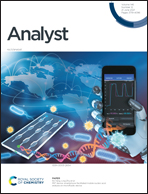Real-time detection and imaging of exogenous and endogenous Zn2+ in the PC12 cell model of depression with a NIR fluorescent probe†
Abstract
Depression is closely related to overactivation of N-methyl-D-aspartic acid (NMDA) receptors, and Zn2+ is a vital NMDA receptor modulator involved in the pathophysiological and physiological processes of depression. Therefore, quantitative and real-time detection of Zn2+ is very important for understanding the pathogenesis of depression. In this work, a near-infrared (NIR) fluorescent probe ISO-DPA was designed and synthesized for Zn2+ detection with a large Stokes shift (185 nm), high quantum yield (up to 44%), high sensitivity (LOD = 0.106 μM) and good pH stability. The probe showed rapid response within 10 s, accompanied by a distinct fluorescence change from faint to bright pink with the fluorescence intensity increasing 4.5-fold. Moreover, the sensing mechanism of ISO-DPA towards Zn2+ was supported by MALDI-TOF-MS and Job's plot. The probe ISO-DPA could detect instantaneous variation of exogenous and endogenous Zn2+ in PC12 cells. The bioimaging results reveal the increase of the endogenous Zn2+ concentration in PC12 cells under the oxidative stress induced by glutamate and confirm that overactivation of NMDA receptors results in an increase of the Zn2+ level. All the results proved that ISO-DPA is an excellent probe for detecting Zn2+ in solution and living cells and could help us better understand Zn2+ associated pathogenesis of depression.



 Please wait while we load your content...
Please wait while we load your content...